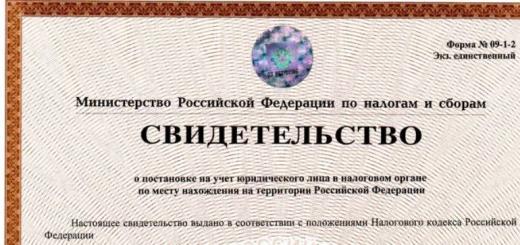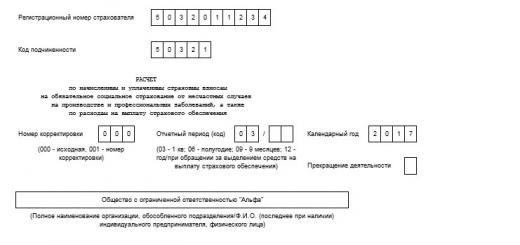We considered the essence of the journal-order form of accounting in. We will tell you more about the journal-warrant No. 1 and give an example of filling it out in our consultation.
What is journal-order 1 used for?
In the journal-warrant No. 1, on the basis of primary accounting documents, in chronological order, information on the credit turnover on account 50 "Cashier" is accumulated and systematized.
In accordance with the Chart of Accounts (Order of the Ministry of Finance dated October 31, 2000 No. 94n), account 50 “Cashier” summarizes information on the availability and movement of cash in the cash desks of the organization.
At the same time, the following sub-accounts can be opened for account 50:
- 50-1 "Cash desk of the organization";
- 50-2 "Operating cash desk";
- 50-3 "Money documents", etc.
More information about the synthetic and analytical accounting of cash transactions can be found in.
Debit turnovers on account 50 are reflected in statement No. 1, which is placed on the back of the journal-order No. 1.
How to keep a journal-order number 1
Based on the reports of the cashier, confirmed by the documents attached to them, at the end of the day, entries are made in the journal-order No. 1 (Letter of the USSR Ministry of Finance dated 08.03.1960 No. 63). If the number of cash documents is insignificant, it is allowed to make entries in the journal-order not daily, but for 3-5 days, in general, according to several reports of the cashier. In this case, the "Date" column indicates the initial and final numbers for which entries are made, for example: 5-7, 21-24, etc.
Journal order 1: filling example
The organization can develop the form of the journal-warrant No. 1 on its own, or can use the sample.
When using computer data processing, the formation of order journals is carried out automatically on the basis of business transactions entered into the accounting program on account 50.
To fill in the journal-order number 1, we will present conditional data on account 50 for October 2016:
| the date | Operation | Account debit | Account credit | Amount, rub. |
|---|---|---|---|---|
| 04.10.2016 | 50 | 51 "Settlement accounts" | 300 000,00 | |
| 05.10.2016 | September salary paid | 70 "Settlements with personnel for wages" | 50 | 260 000,00 |
| 05.10.2016 | Funds issued for a business trip report | 71 "Settlements with accountable persons" | 50 | 29 000,00 |
| 11.10.2016 | Received cash proceeds from the sale of goods | 50 | 90 "Sales" | 80 000,00 |
| 11.10.2016 | Deposited money to the bank | 57 "Transfers on the way" | 50 | 80 00,00 |
| 14.10.2016 | Earned cash receipts | 50 | 90 | 170 000,00 |
| 14.10.2016 | Cash received from bank by check | 50 | 51 | 100 000,00 |
| 14.10.2016 | Advance payment issued for October | 70 | 50 | 190 000,00 |
| 18.10.2016 | Issued an interest-free loan to an employee | 73 "Settlements with personnel for other operations" | 50 | 20 000,00 |
| 27.10.2016 | Unused accountable funds returned to the cashier | 50 | 71 | 8 000,00 |
| 28.10.2016 | There was a shortage at the checkout | 94 "Shortages and losses about damage to valuables" | 50 | 250,00 |
- entries in journals-orders are made in the order of registration of transactions only on the credit of the account, in correspondence with debited accounts;
- records of synthetic and analytical accounting, as a rule, are combined in one register;
- business transactions are reflected in accounting in the context of indicators that are necessary for control and reporting;
- combined journals-orders for accounts are used, which are economically and methodologically interconnected;
- monthly journals-warrants are applied.
An example of a journal-order form of accounting
Bookkeeping in the journal-order form consists in the accumulation and systematization of data in accounting registers during the month in chronological order. At the same time, both synthetic and analytical accounting, as well as chronological and systematic recording of business transactions, are kept.
In the journal-order form of accounting, as a rule, only two types of accounting registers are used: order journals and auxiliary statements. In some cases, for a more rational generalization or grouping of credentials, special development tables can be used.
The totals of the order journals at the end of the month are transferred to the General Ledger.
Let us illustrate the journal-order form of accounting using the example of journal-order No. 1:
Magazine-order No. 1 on account 50 "Cashier"
If an organization has chosen a journal-order form of accounting for accounting, then it should be guided by the Letter of the USSR Ministry of Finance dated March 8, 1960 No. 63 “On instructions for the use of a unified journal-order form of accounting”, as well as the Letter of the Ministry of Finance of the Russian Federation dated July 24, 1992 year No. 59 "On recommendations for the use of accounting registers in enterprises." Small enterprises can be guided by the Letter of the USSR Ministry of Finance dated June 6, 1960 No. 176 "On instructions for the use of a single journal-order form of accounting for small enterprises and business organizations."
The journal-order form of accounting is based on the principle of accumulating data from primary accounting documents in such a way as to provide synthetic and analytical accounting of funds and business transactions in all sections of accounting. Accumulation of data is carried out in accounting registers, which makes it possible to reflect all the funds subject to accounting and business transactions for the use of these funds for the reporting month and eliminates the need to draw up memorial orders.
Chronological and systematic recording of business transactions is carried out simultaneously, while there is no register of business transactions.
Entries in the registers are made in the context of indicators that allow for the management of the financial and economic activities of the enterprise, as well as for the preparation of interim and annual reports.
In the journal-order form of accounting, as a rule, two types of accounting registers are used - journal-orders and auxiliary statements. In order to group some credentials, special development tables can also be used.
Order journals are the main accounting registers, auxiliary statements are used in cases where it is necessary to group the analytical data of primary documents. The results of the statements are transferred to order journals.
The construction of both journals - orders and auxiliary statements is based on the credit sign of registration of business transactions on synthetic accounts. Synthetic data are registered according to the data of primary documents only on the credit of the corresponding accounts in correspondence with the debited accounts.
The final data of the order journals at the end of the month are transferred to the General Ledger, according to which the balance sheet is compiled using, if necessary, individual indicators from the accounting registers.
Based on the principle of registering credentials on a credit basis, entries on the credit of each synthetic account in correspondence with debited accounts are made entirely in one of any journal-order. Debit turnovers on the corresponding synthetic account are revealed in various order journals, as they register entries on the credit of the accounts corresponding to it. After transferring the total data from all order journals to the General Ledger, it reveals the debit data for each account.
Debit turnovers on accounts for which synthetic and analytical accounting is kept in single registers are also reflected in order journals intended for registering entries on the credit of these accounts. Order journals, in which, along with records on the credit of certain synthetic accounts, analytical accounting is also maintained, contain two sections: one records transactions on the credit of the account, and the other reflects indicators of analytical accounting.
Order journals are constructed in such a way that they reflect transactions that are homogeneous in economic content, as well as transactions related to each other, therefore some order journals are designed to reflect credit operations of several synthetic accounts that are identical in economic content. In this case, a section or column is assigned to each of them in the register.
In order to ensure the correct grouping of data from primary documents in the journal-orders, standard correspondence on the credit of accounts and a list of indicators necessary for the preparation of monthly, quarterly and annual reports are provided. In order journals intended for synthetic and analytical accounting, the necessary positions for analytical accounting are also provided.
The construction of a single journal-order form of accounting is based on the following key principles:
Entries in journals-orders are made in the order of registration of operations only on the credit of the account in correspondence with the debit of the accounts;
Combination in a single system of records of synthetic and analytical accounting;
reflection in the accounting of business transactions in the context of indicators necessary for monitoring and compiling periodic and annual reports;
· the use of journal-orders for sets that are economically related to each other;
· the use of registers with pre-specified correspondence of accounts, the nomenclature of articles of analytical accounting, indicators necessary for reporting;
Use of monthly journals-orders.
The final entries in the journal-orders are subject to mandatory reconciliation with the data of primary documents, which allows you to control the correctness of accounting for business transactions. If the entries in the order journals cannot be controlled by comparing them with the corresponding indicators of other accounting registers, the total loan total is put down on the basis of the calculation of the amounts for the primary documents.
Amounts attributable to the debit of accounts for which analytical accounting is maintained in the corresponding journals-orders or statements are deciphered and grouped by sub-accounts or articles of analytical accounting. Such a decryption can be carried out in special decryption sheets compiled on a debit basis, that is, a separate decryption sheet is opened for each debited account.
In order journals that reflect analytical data, records are made on them with monthly totals, while the totals are established by calculating the amounts for the relevant documents, preliminarily grouped in the context of the required analytical data.
All registers indicate the name of the month in which they are filled out, and, if necessary, the names of synthetic accounts. At the end of the month, the registers are signed by the persons who made the entries. All journal-orders are signed by the chief accountant of the enterprise or a person authorized by him. In the registers from which the necessary indicators are transferred to the General Ledger or to other registers, a corresponding mark is made.
The general ledger is used to summarize data from order journals, mutually check the correctness of entries made for individual accounts, and to draw up a balance sheet. The General Ledger shows the opening balance, current turnover and closing balance for each synthetic account. Recording the current turnover in the General Ledger is at the same time the registration of accounting data reflected in the order journals.
In the General Ledger, current turnovers are made only for first-order accounts. The credit turnover of each synthetic account is reflected in one entry, and the debit turnover - in correspondence with credited accounts.
Checking the correctness of the entries made in the General Ledger is carried out by calculating the amounts of turnover and balances for all accounts. The sums of debit and credit turnovers, as well as debit and credit balances, must be equal.
The general ledger is opened for a year, one or two sheets are allocated for each account. If two sheets are opened, then the second sheet is used as a supplement to the main one.
The journal-order form of accounting is currently the most progressive and widespread. It is she who, as a rule, is used in accounting automation programs.
The journal-order form combines chronological and systematic, analytical and synthetic accounting registers. Order journals are maintained on the basis of primary documents.
1. On the basis of primary documents, business transactions are recorded in accumulative statements, that is, they are recorded in the journal of business operations. An example of a journal of business operations of an organization for January is given in Table. 6.1.
Table 6.1
2. Then these business transactions are recorded in order journals and additional statements.
As an example, journals-orders and statements on accounts 50 and 51 are given, compiled on the basis of data from the journal of business transactions.
The results of business transactions for one account or a group of accounts are transferred to order journals, therefore order journals have certain numbers, for example, order journal No. 1 is kept on account 50 “Cashier” (Table 6.2), order journal No. 2 - on account 51 “Settlement accounts” (Table 6.3), journal-order No. 3 - on accounts 55 “Special accounts in banks”, 57 “Transfers on the way”, journal-order No. 4 - on accounts 66 “Settlements on short-term loans and loans”, 67 “Settlements on long-term credits and loans”, etc. Journals-orders are compiled on the basis of a credit basis of accounts, i.e. they reflect the transactions that took place on the credit of this account in correspondence with the debit of other accounts.
Statements are additionally maintained for cash accounts 50 and 51: statement No. 1 on account 50 (Table 6.4) and statement No. 2 on account 51 (Table 6.5). The statements are compiled on the debit basis of accounts, i.e., they reflect the transactions that took place on the debit of this account in correspondence with the credit of other accounts.
3. The final data for each journal-order are transferred to the General Ledger, which is opened for a year and is maintained for each account, for example, account 50 "Cashier" (Table 6.6).
Table 6.2
| operation number | In credit accounts 50 from debit accounts | Total | ||||
| ... | ... | |||||
| Total | ... |
Accounting for the journal-order form is carried out as follows. The primary documents received by the accounting department are processed by the accountant within two days from the date of receipt. Processing consists in verifying the authenticity of documents, their compliance with the law and the availability of the necessary details.
┌───────────────────┐
┌────┤Primary documents├────────────┐
│ └─────────┬─────────┘ │
│ ┌─────────┴─────────┐ │
│ │Tables, sheets,│ │
│ │ cards │ │
│ └─────────┬─────────┘ │
│ ┌─────────┴─────────┐ ┌──────┴──────┐
└───│ Journals - orders ├───┤ Cash │
└──────────┬───────────┘ │ book │
└─────────────┘
┌─────────┴─────────┐
│ General ledger │
└─────────┬─────────┘
┌─────────┴─────────┐
│Balance and reporting│
└───────────────────┘
Fig.4.1. Scheme of the journal-order form
In addition, processing includes entering information from these documents into the relevant registers, cards, tables, statements and coding business transactions in the form of accounting entries. (Information on a number of transactions is not entered into supporting documents, but is immediately entered into order journals.) Cash settlements are additionally drawn up in the cash book, and then transferred from it to the corresponding order journals.
The main difference between the journal-order form and other forms lies in the journal-orders and in the General Ledger. Arithmetic processing of accounting entries is carried out in order journals, full turnovers on credit accounts and partial turnovers on debit accounts are calculated. Then the information from the journal-orders is transferred to the general ledger, where the total turnover on the debits of the accounts is calculated and the final balances for all accounts are determined.
According to the information from the General Ledger, a balance sheet is drawn up and the company's reporting is prepared (monthly, quarterly and annual).
Currently, large and medium-sized enterprises use a 16-journal form, supplemented by a set of statements.
The list of journal-orders (J-O) of this form is presented below:
J-O N 1 "Cashier" (account 50);
G-O N 2 "Settlement accounts" (account 51, 57) and G-O N 2/1 "Currency accounts" (account 52, 57);
J-O N 3 "Special accounts in banks" (account 55);
J-O N 4 "Accounting for credits and loans" (accounts 66, 67);
J-O N 5 "Accounting for financial investments" (account 58);
G-O N 6 "Settlements with suppliers and contractors" (account 60) and G-O N 6/1 "Accounting for operations for the procurement and acquisition of material assets" (accounts 15, 16);
J-O N 7 "Settlements with accountable persons" (account 71);
J-O N 8 "Settlements with different debtors and creditors" (accounts 58, 62, 68, 73, 75, 76);
J-O N 9 "Intra-economic settlements" (account 79);
J-O N 10 and J-O N 10/1 "Accounting for production costs" (accounts 02, 04, 05, 10, 11, 15, 16, 19, 20, 21, 23, 25, 26, 28, 29 , 40, 46, 69, 70, 76, 94, 97);
G-O N 11 "Accounting for shipment and sale" (accounts 41, 42, 43, 44, 45, 62, 90) and G-O N 11/1 "Accounting for the sale and disposal of fixed assets and intangible assets" (accounts 01, 03, 04, 91).
J-O N 12 "Accounting for sources of own funds and targeted income" (accounts 14, 59, 63, 80, 81, 82, 83, 84, 86, 96).
G-O N 13 "Accounting for own fixed assets, long-term leased fixed assets and intangible assets" (accounts 01, 03, 04, 91).
J-O N 14 "Accounting for the revaluation of values" (account 14, 59).
Zh-O N 15 "Accounting for profit, its use and deferred income" (accounts 84, 91, 98, 99).
J-O N 16 "Accounting for capital investments" (accounts 07, 08, 11).
Notes: Journal-order N 5 is opened with a large volume of accounting in journal-order N 8. Journal-order N 6/1 is opened as needed, otherwise accounts 15 and 16 are included in journal-orders N 10 and N 10/1. Journal-order N 11/1 can be replaced by journal-order N 13.
With an average and small volume of accounting, an 8-journal form can be used, in which journal-orders group accounts according to economic characteristics:
J-O N 1 "Accounting for funds" (accounts 50, 51, 52, 55, 56, 57, 58);
J-O N 2 "Accounting for credits, loans, loans" (accounts 66, 67);
G-O N 3 "Accounting for fixed assets and authorized capital" (accounts 01, 02, 03, 04, 05, 80, 81);
J-O N 4 "Accounting for production" (accounts 10, 14, 15, 16, 19, 20, 21, 23, 25, 26, 28, 29, 40, 46, 97);
J-O N 5 "Accounting for shipment and sale" (accounts 41, 42, 43, 44, 45, 90, 91);
J-O N 6 "Accounting for settlements" (accounts 60, 62, 68, 69, 70, 71, 73, 75, 76, 79);
J-O N 7 "Accounting for income and reserves" (accounts 59, 63, 82, 83, 84, 91, 94, 96, 98, 99);
J-O N 8 "Accounting for capital investments" (accounts 07, 08, 11).
Consider the principles of building order journals and the General Ledger.
The journal-order is a table in which the data of business transactions are entered on a credit basis.
For a visual representation of the mechanism for generating order journals, processing the information received in them and transferring them to the General Ledger, as well as compiling the General Ledger and processing business transaction data in it, we will consider a specific simplified numerical example.
They are determined by the following features: the number, structure and appearance of accounting registers, the sequence of communication between documents and registers, as well as between the registers themselves and the method of recording in them, that is, the use of certain technical means. Therefore, the form of accounting should be understood as a set of various accounting registers with the established procedure and method of recording in them.
The organization, unless otherwise provided by applicable law, independently chooses the most suitable accounting system for itself. The choice of system is determined either by the already established accounting practice, or by the capabilities and professional training of the accountant.
There are already proven accounting systems that are recommended by the competent government authorities in some cases even for mandatory use. These include:
- simple accounting system(without double entry of business transactions);
- memorial order accounting system;
- journal-order accounting system with its modifications (simple, simplified, complete or typical).
With the widespread introduction of electronic computing technology, a clear classification of accounting systems has become almost impossible, that is, all accounting programs allow in practice to form any combination of generally accepted accounting systems.
The accounting system must comply with the type, be completely reliable, exclude the possibility of missing information about economic activities, allow any sampling of the state, movement or sources of funds of the organization, ensure simplicity in registering business transactions and compiling financial statements, have protection against leakage of commercial information, have an acceptable cost.
The cost of the accounting system used should be directly proportional to business turnover organization and not reduce its profitability.
Memorial-order form of accounting
Rice. 1.1. Scheme of the memorial order form of accounting (solid lines show the sequence of accounting records, dotted lines show reconciliation of results).Memorial-order form of accounting(Fig. 1.1) is a set of memorial orders, each of which groups postings for homogeneous business transactions based on the results of one month of the organization's work. The composition and number of memorial orders in the accounting system depend on the content, quantity, and degree of repeatability of business transactions. Each memorial order must have its own details. Depending on the size of the organization and its accounting service, orders are drawn up by an accountant or chief accountant, and then checked and signed by the chief accountant. The list of memorial orders is approved by the director of the organization for the financial year.
With the memorial-order form of accounting, synthetic accounting is kept in books or multigraph sheets. For analytical accounting, books, statements, cards are used.
A memorial order is drawn up for each business transaction. If a group of business transactions is combined in a consolidated document, then a memorial order is drawn up for a group of transactions. The memorial order must indicate the accounting entry, the date of its compilation and the amount. A memorial order can be drawn up as a separate document. In some cases, a place for a memorial order is provided on the forms or a corresponding stamp is made on the documents.
Most of the transactions during the month are grouped in auxiliary accumulative statements. Then, according to these statements, memorial warrants are drawn up once a month.
Compiled memorial warrants are recorded in chronological order in the registration journal. Each memorial order is assigned a specific serial number.
After being reflected in the registration journal, the data of memorial orders are recorded in the General Ledger or in a multi-graph sheet that replaces it.
In the General Ledger, on the left side of the account, data on business transactions are reflected on the debit, and on the right side of the account - on the credit.
Accounts have a polygraph form, in which the corresponding accounts are indicated for the debit and credit of the account. Such a system of reflecting business transactions in the General Ledger provides simplicity and clarity of records.
The totals for the debit and credit of the General Ledger accounts are recorded in the turnover sheet, which is built using synthetic accounts.
Based on the entries in the analytical accounts, turnover sheets of analytical accounting are compiled, which are compared with the turnover sheet for synthetic accounts. The debit and credit turnover of synthetic accounts is checked against the turnover in the register of memorial orders.
With the memorial-order form of accounting, the organization's balance sheet is compiled on the basis of a turnover sheet for synthetic accounts.
The memorial-order form of accounting is distinguished by a strict sequence of the accounting process, the simplicity and accessibility of accounting equipment, the widespread use of standard forms of analytical registers, keyboard computers, and a copy method of registration. However, it has significant drawbacks: the compilation of a large number of memorial orders, duplication of the same data in various accounting registers. In addition, separate maintenance of synthetic and analytical accounting registers leads to a lag of analytical accounting from synthetic.
Journal-order form of accounting
At the core journal-order form of accounting(Figure 1.2) are the principles of accumulating and systematizing data from primary documents in accounting registers, which allow for synthetic and analytical accounting of funds, sources of business transactions in all sections of accounting. This eliminates the need for compiling memorial warrants.
Chronological and systematic records of business transactions are carried out simultaneously. The journal of chronological registration of economic turnover is not kept.
Entries in accumulative registers are made in the context of indicators necessary for managing the financial, economic and commercial activities of the organization, as well as for preparing monthly, quarterly and annual reports.
When conducting analytical and synthetic accounting, two types of accounting registers are used: order journals and auxiliary statements. To ensure the rationality of accounting, special development tables can be used.

For some types, for which there is a significant number of personal accounts, analytical accounting cards can be entered. Based on their data, turnover sheets are compiled at the end of the month.
In addition, with the journal-order form of accounting, inventory cards or books of accounting for fixed assets, cards or statements of accounting for production costs for calculated objects, as well as sorted (balance or turnover) statements for accounting for finished products are maintained.
The main registers of this form of accounting are order journals. They are free sheets of large format with a significant number of details. Journals-orders are opened for a month for a separate synthetic account or for a group of synthetic accounts. Each journal-order is assigned a specific permanent number.
Entry in order journals is made daily, either directly from primary documents or from auxiliary statements. Auxiliary statements are usually used in cases where the necessary analytical indicators are difficult to obtain directly in order journals. Therefore, the data of primary documents are preliminarily grouped in statements, and their totals are then transferred to order journals.
The construction of order journals and auxiliary statements is based on the credit sign of registering business transactions, i.e., the data of primary documents are recorded only on the credit of the corresponding accounts while simultaneously reflecting the turnover on the debit of the corresponding accounts. This eliminates the duplication of turnover on the corresponding accounts. The results for the month of each journal-order show the total amount of the credit turnover of the account, the operations of which are recorded in this journal, and the sum of the debit turnovers of each account corresponding to it.
Business transactions are recorded in order journals as they are completed and documented. Therefore, a systematic entry in order journals serves simultaneously as a chronological entry. The need to maintain special chronological registers with this form of accounting is eliminated. Memorial warrants are also not drawn up, since all indicators are recorded in the context of corresponding accounts.
To check the correctness of the entries in the order journals, the total credit of the account is calculated and recorded in the journal directly from the documents. The resulting total is compared with the totals for debited accounts displayed in separate columns of the journal. Such a reconciliation makes it superfluous to compile turnover sheets for journals in which synthetic accounting is combined with analytical. Turnover statements are compiled only for those accounts in which analytical accounting is maintained independently.
The totals of the order journals at the end of the month are transferred to the General Ledger.
The general ledger is opened for a year and serves to summarize data from order journals, mutually verify the correctness of entries made on individual accounts, and to compile a balance sheet. It records the balance at the beginning of the month (year), debit and credit turnover of accounts and the balance at the end of the month (year) for each synthetic account.
The credit turnover is transferred to the General Ledger from the corresponding journal, the debit turnovers are recorded in the ledger from different journals-orders for corresponding accounts. After checking the turnover, the balance at the beginning of the next month is displayed, which is recorded in the corresponding column of the General Ledger.
To check the correctness of entries in the General Ledger, the sums of turnovers and balances for all accounts are calculated. The sums of debit and credit turnovers, as well as debit and credit balances, must be equal.
And other forms of reporting are compiled according to the General Ledger, order journals and statements auxiliary to them.
When using the journal-order form of accounting, there is no need to draw up a chess control sheet and a chess balance, as well as a balance of turnovers on accounts. The use of the journal-order form of accounting can significantly reduce the complexity of accounting by combining synthetic and analytical accounting, systematic and chronological records, and canceling a number of records in one register. This form of accounting increases the control value of accounting and facilitates reporting. The disadvantages of the journal-order form of accounting include the complexity and cumbersomeness of building journal-orders, focused on filling in data manually and complicating the mechanization of accounting.
In the context of the use of various types of electronic computers, the orientation of organizations to improve management and develop market relations, an automated form of accounting is increasingly being introduced, which is based on the principle of double entry when recording business transactions. Simultaneous recording of a business transaction in debit and credit of the corresponding accounts contributes to the systematization of business transactions and provides effective control over the correct reflection of them in the accounting accounts.
Typical business transactions are pre-coded. For those business transactions that are non-systematic, the principle of preliminary accumulation of information is used.
Automated control systems make it possible to obtain information not only on the object as a whole, but also on its individual parts: on a specific supplier of materials, a specific buyer of products, etc. equipment. The initial information is processed in a computer according to different programs, taking into account the solution of specific problems, depending on the requirements of information users.
With an automated form of accounting, an organic relationship is provided between accounting, operational and statistical accounting.
The improvement of the organization of accounting is largely facilitated by the automated workstations of accountants created in organizations (AWS).










